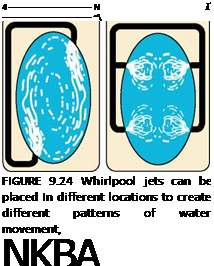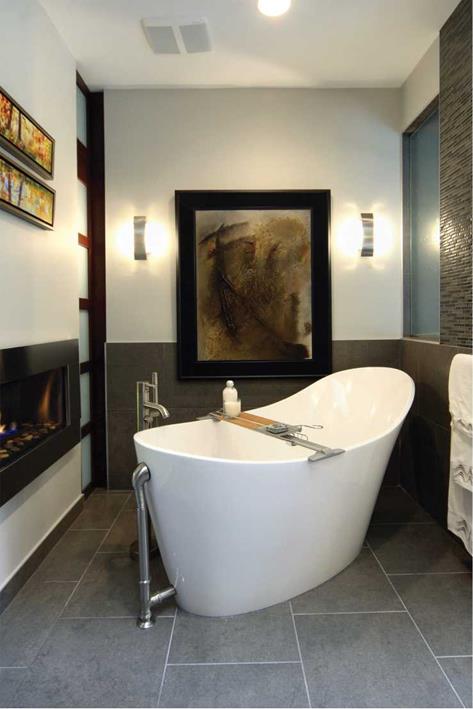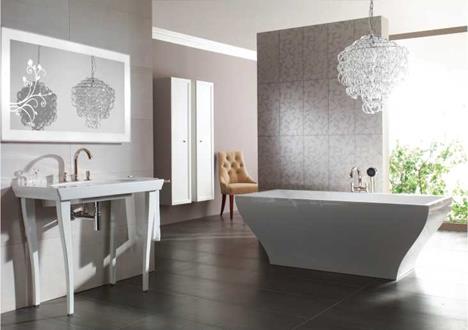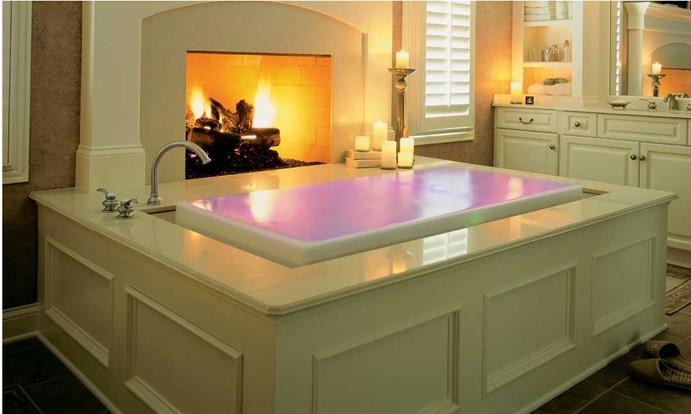|
Massage
There are many types of massage treatments and body works that are used to help clients to relax, reduce pain, and tone muscles. The specific type of massage will depend on the massage therapist and the needs of the client. Although the bath designer will not need to know all of the types of massage treatments, it might be helpful to be familiar with a few of the techniques.
• Cranio-sacral massages focus on the head and neck area to loosen tight neck muscles.
• Deep tissue massage releases tension in deeper muscle layers by using slow strokes and finger pressure on contracted muscle areas.
• Feldenkrais massage is a clothes-on massage that helps with sports injuries and tension.
• Reflexology is a massage based on a system of points or meridians in the hands and feet that correspond to organs in the body.
• Reike is a body work technique using subtle stationary hand positions on points of tension or injury.
• Shiatsu is a body work technique of acupressure used on pressure points to improve energy flow.
• Swedish massage uses long strokes, kneading, and friction techniques to relax muscles.
• Trager body work techniques help with joint movement.
Spa Supplies and Equipment
A home spa will need certain basic supplies and equipment, but it could be created in a bathroom with a bathtub and shower. The items depend on the treatments the client is using, but may well include candles, body brushes, loofahs, sponges, scrubbing mitts, oils, moisturizers, muds, towels, sheets, pillows, and a varied supply of nail care products. The more elaborate treatments require wet rooms and lounge chairs.
Whirlpools
Whirlpools or jetted bathtubs are one of the most requested items in new and remodeled baths and provide the client with a form of hydrotherapy. Many new homebuyers expect a whirlpool tub in the master suite, and whirlpools are frequently placed in remodeled bathrooms that contain a tub and shower. Small 60 inch by 32 inch (1 524 mm by 813 mm) models are available and are more efficient with both water and energy used to heat. Deep two-person models are also available.
Consider who will be using the whirlpool and how much space they require. The shape of the seating, padding, and angled support determine the user’s comfort while in the tub. Ideally the client will be able to sit in a working tub before selecting it, to see if it is comfortable and if the water action meets their expectations.
 Whirlpools are filled with heated water each time they are used. They have different jetted actions that move the water in the tub. This is an important variable in design and selection of the units. Some may have jets that force the water out at certain locations. Other jet actions may move the water in a rotating pattern.
Whirlpools are filled with heated water each time they are used. They have different jetted actions that move the water in the tub. This is an important variable in design and selection of the units. Some may have jets that force the water out at certain locations. Other jet actions may move the water in a rotating pattern.
The number of jets and their location in relation to the bather (Figure 9.24) determine how effective they are as hydrotherapy. Air bubblers may line the bottom of the tub creating a soft massaging movement. The number of jets, and the integration of jets and air bubblers, will affect the quality of the whirlpool experience. The system should be integrated so that it works efficiently.
Whirlpool users will sit in the warm water (103/104°F [39.4/40°C] for adults) for about 15 to 20 minutes. It is important to think about the user’s view (Figure 9.25), which is why the tubs are often placed at a window. Some tubs come with DVD/CD/AM/FM stereo surround sound systems and plasma screen televisions, so the user can listen to relaxing music (or watch an action movie if desired). Tubs also may have different colored lights within the water to enhance chromatherapy.
Other features to consider in selecting a whirlpool are electronic touch pads and remote controls. Extra water heaters, such as an in-line water heater, may be needed to handle the demand of the larger tubs. The designer must plan for the location of the access panels, so that maintenance and repairs can be completed. Often a handheld shower is mounted on the whirlpool tub deck.
 |
 |
Spa Tubs
Spa tubs are often referred to as hot tubs. They offer some of the same relaxing options as the whirlpool, but the water remains in the tub and is re-used. The water is thermostatically controlled and stays heated. Skimmers and filters are essential to maintain water quality. An insulated cover keeps the moisture and heat in the tub.
Spa tubs are not used for bathing. Users should shower before entering the hot tub. Some larger hot tubs are more suited for a social area since they can handle up to ten people. Often these are placed outside and are accessible from the public parts of the house.
 |
 |
Soaking Tubs
Soaking tubs have become a popular option in the spa bathroom. They are deeper than standard tubs—25 inches (635 mm) instead of 1 5 inches (381 mm)—and they are often longer—as much as 78 inches (1981 mm). They relax the user by having them sink to their necks in warm water (Figure 9.26). Users should shower before entering, since soaps are not to be used in soaking.
Some of these tubs are freestanding and come in a variety of materials, such as copper, wood, acrylics, and marble. The form of the tub can be designed to support the back or legs. A Japanese soaking tub is smaller and deeper, with a seat that the bather uses to submerge into the water.
Often soaking tubs are designed for a wall – or floor-mounted faucet. A larger hot water tank will be needed and extra reinforcement in the floor is necessary to support the weight of the filled tub.
Steam Bathtubs or Showers
These bathtubs or showers can be freestanding, or a system can be added to a standard shower or tub/shower design. The same considerations presented in chapter 6, "Bathroom Planning," for designing a shower should be followed. However, the shower or bathtub must be sealed from the edge of the fixture to the ceiling to create the steam room. Seating is needed (Figure 9.27) and the controls must be placed within the steam room (Figure 9.28).
Saunas and Infrared Rooms
These are separate insulated rooms lined with cedar (Figure 9.29). In a sauna, a separate heater with rocks is placed in the room. Water can be sprinkled on the rocks occasionally to create steam at a low humidity to relieve the dryness in the sauna. In an infrared room, multiple infrared heaters are placed along the wall to provide direct heat on each user. The sauna or infrared room should allow at least 4 square feet (0.37 square meters) (6 square feet or 0.56 square meters is preferred) of space per person. The doors must swing out and should not lock. The sauna should be planned with the shower located nearby.
The bench in the sauna or infrared room should be 24 inches (610 mm) deep to allow for sitting and lying down. It should be about 18 to 20 inches (457 to 508 mm) high. A slanted back can also be provided to add a place to recline. Benches can be tiered to provide more seating, but a higher ceiling may be needed (Figure 9.30).
|




